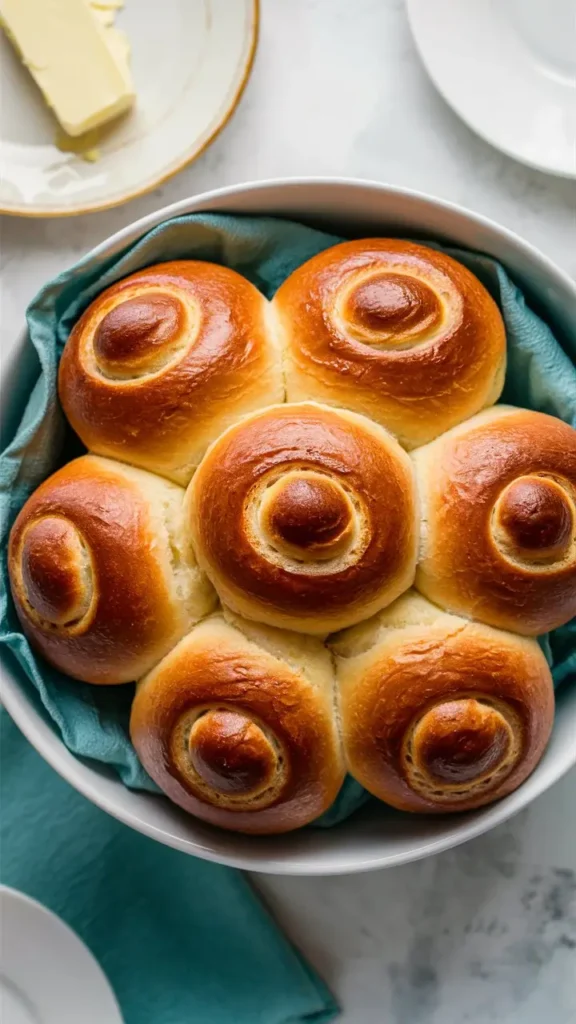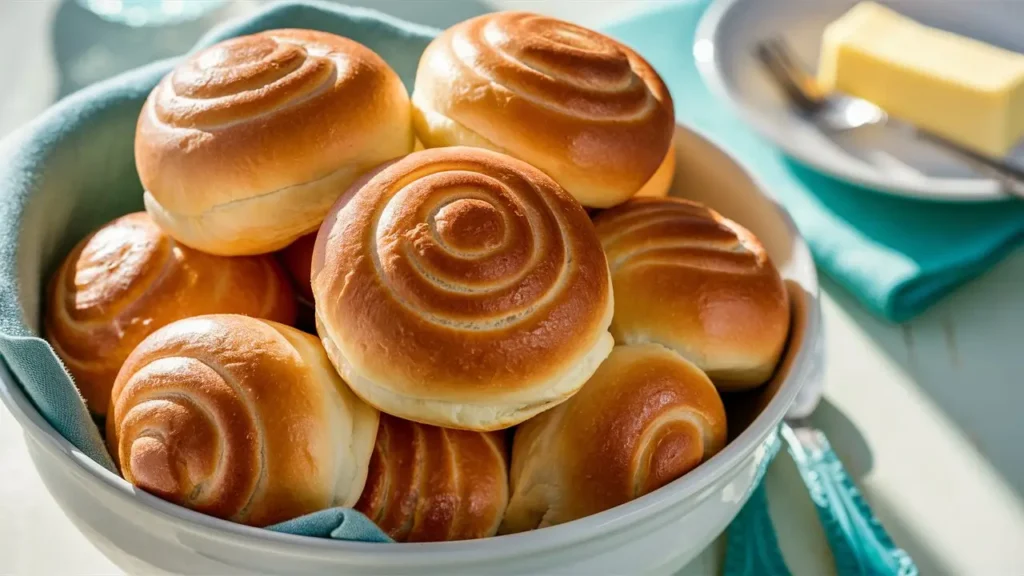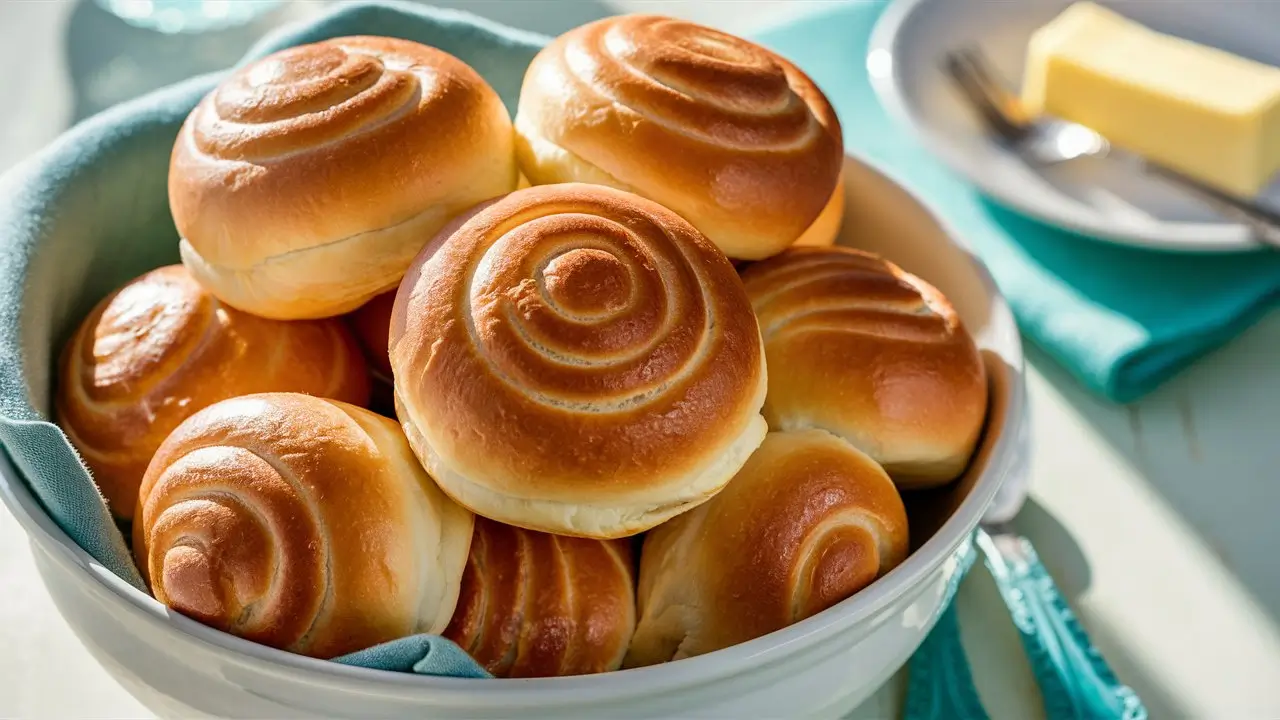Parker House Rolls recipe are a timeless classic in American baking, known for their soft, buttery texture and unique folded shape. These slightly sweet dinner rolls are perfect for holiday feasts, special occasions, or everyday meals when you want something warm and comforting to serve alongside your main dish. Whether you enjoy them plain, slathered with butter, or as mini sandwich buns, Parker House Rolls bring a touch of elegance and nostalgia to the table.
Why You Will Love This Recipe
-
Soft and Fluffy Texture – Enriched with butter and milk, these rolls have a pillowy interior and golden crust.
-
Unique Folded Shape – The signature half-moon fold sets these rolls apart from others.
-
Great for Make-Ahead – The dough can be prepped ahead and refrigerated overnight.
-
Perfect for Any Occasion – Ideal for weeknight dinners, holiday spreads, or potlucks.
Ingredients List
Here’s everything you’ll need to make Parker House Rolls from scratch:
-
4 cups all-purpose flour (plus more for kneading)
-
2¼ teaspoons active dry yeast (1 packet)
-
1 cup warm milk (about 110°F)
-
¼ cup granulated sugar
-
1½ teaspoons salt
-
1 large egg
-
½ cup unsalted butter (softened)
-
Additional melted butter for brushing
Optional:
-
Flaky sea salt or herbs for topping
Timing & Servings
-
Prep Time: 25 minutes
-
Rising Time: 2 hours
-
Bake Time: 15–18 minutes
-
Total Time: ~3 hours (including rising)
-
Servings: 18–20 rolls
Step-by-Step Instructions for Parker House Rolls Recipe
Step 1: Proof the Yeast
In a large mixing bowl, combine the warm milk, sugar, and yeast. Stir and let it sit for 5–10 minutes until frothy. This step activates the yeast.
Step 2: Mix the Dough
Add the egg, salt, softened butter, and 3½ cups of the flour to the yeast mixture. Mix until a sticky dough forms. Gradually add the remaining flour, a tablespoon at a time, until the dough pulls away from the sides.
Step 3: Knead the Dough
Turn the dough out onto a lightly floured surface and knead for 8–10 minutes until smooth and elastic. You can also use a stand mixer with the dough hook attachment for about 5 minutes.
Step 4: First Rise
Place the kneaded dough in a greased bowl, cover with a clean kitchen towel or plastic wrap, and let it rise in a warm place for 1½ hours, or until doubled in size.
Step 5: Shape the Rolls
Punch down the dough and roll it out on a floured surface to about ½ inch thick. Use a round cutter (2½–3 inches) to cut circles. Brush each circle with melted butter and fold in half, pressing lightly to seal the edge.
Step 6: Second Rise
Arrange the folded rolls on a greased or parchment-lined baking sheet. Cover loosely and let them rise again for about 30–45 minutes until puffy.
Step 7: Bake the Rolls
Preheat your oven to 375°F (190°C). Bake the rolls for 15–18 minutes until golden brown on top.
Step 8: Brush with Butter
As soon as they come out of the oven, brush generously with melted butter for that signature shine and flavor.

Tips for Success
Don’t Overheat the Milk
Milk that’s too hot can kill the yeast. Aim for around 110°F, which feels warm but not hot to the touch.
Use Fresh Yeast
Check the expiration date on your yeast to ensure proper rising. Old yeast can result in dense rolls.
Fold Rolls Evenly
Press each folded roll gently but firmly enough to keep its shape. This signature fold helps the roll open slightly while baking.
Variations on Parker House Rolls
Herb-Infused Butter
Mix finely chopped rosemary, thyme, or parsley into the melted butter for brushing before folding or after baking.
Garlic Butter Rolls
Add minced garlic to the melted butter for a savory touch.
Cheesy Parker House Rolls
Sprinkle a little shredded cheddar or parmesan between the folds before baking for a cheesy surprise.
Make-Ahead Instructions
Refrigerate the Dough
You can make the dough a day ahead and refrigerate it after the first rise. Just bring it to room temperature before shaping.
Freeze the Rolls
Shaped (but unbaked) rolls can be frozen on a tray until solid, then transferred to a zip-top freezer bag. When ready to bake, thaw, rise, and bake as usual.
Storage and Reheating
How to Store
-
Store leftover rolls in an airtight container at room temperature for up to 3 days.
-
For longer storage, freeze the baked rolls for up to 2 months.
How to Reheat
-
Oven: Wrap in foil and warm at 300°F for 10 minutes.
-
Microwave: Cover with a damp paper towel and heat for 20–30 seconds.
Serving Suggestions
Parker House Rolls are the perfect side for:
-
Thanksgiving or holiday dinners
-
Roast chicken, ham, or turkey
-
Soups and stews
-
Breakfast sandwiches
-
Sliders with pulled pork or brisket
Nutritional Overview (Per Roll, Approximate)
-
Calories: 140
-
Carbohydrates: 20g
-
Protein: 3g
-
Fat: 6g
-
Fiber: 1g
-
Sugar: 3g
Note: Nutrition will vary depending on the ingredients and portion size.
The History of Parker House Rolls
These iconic rolls originated at the Parker House Hotel in Boston in the 1870s. They quickly gained national recognition for their signature folded shape and buttery softness. Today, Parker House Rolls remain a cherished part of traditional American cuisine, often gracing tables at Thanksgiving and holiday feasts.
FAQs
Why are they called Parker House Rolls?
They were created at the Parker House Hotel in Boston and named accordingly.
Can I use instant yeast instead of active dry yeast?
Yes. You can skip the proofing step with instant yeast and mix it directly with the dry ingredients.
Can I make these rolls vegan?
You can substitute plant-based milk and vegan butter, and use a flax egg (1 tbsp flax meal + 3 tbsp water) to make them vegan.
Can I add whole wheat flour?
Yes, but only substitute up to half the flour with whole wheat to maintain softness.
Conclusion
Parker House Rolls are a delightful blend of heritage, taste, and texture. Their fluffy interior and buttery layers make them irresistible at any meal. Whether you’re making them for the first time or it’s a beloved family tradition, this recipe delivers a batch of tender, golden, bakery-quality rolls every time.
